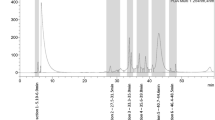Abstract
Quercetin (3,3′,4′,5,7-pentahydroxyflavone) is a polyphenolic flavonoid compound and is found in a variety of plants. Potential biological activities including antioxidant and anticarcinogenesis have been reported. The antiproliferative effect and apoptosis inducing effect of quercetin in human osteosarcoma cells was evaluated in this study. The IC50 values were 290 μM and 160 μM at 24 h and 48 h incubation, respectively. Antiproliferative action of quercetin appeared to be linked to apoptotic cell death based on increase in the sub-G1 apoptotic cell population analyzed by flow cytometric analysis. Prior to apoptosis induction, quercetin caused cell cycle arrest at G1/S phase. The G1/S phase arrest was accompanied by down regulation of cyclin D1, one of the cyclins required for advance from G1 to S. Subsequent apoptosis was induced by the gradual activation of caspase-3 and the cleavage of PARP.
Similar content being viewed by others
References
Aalinkeel, R., Bindukumar, B., Reynolds, J. L., Sykes, D. E., Mahajan, S. D., Chadha, K. C., and Schwartz, S. A., The diatary biflavonoid, quercetin selectively induces apoptosis of prostate cancer cells by down-regulating the expression of heat shock protein 90. Prostate, 68, 1773–1789 (2008).
Bertrand, R. and Sané, A. T., Caspase inhibition in camptothecin-treated U-937 is coupled with a shift from apoptosis to transient G1 arrest followed by necrotic cell death. Cancer Res., 59, 3565–3569 (1999).
Brohem, C. A., Sawada, T. C., Massaro, R. R. et al., Apoptosis induction by 4-nerolidylcatechol in melanoma cell lines. Toxicol. In Vitro, 23, 111–119 (2009).
Choi, E. J., Bae, S. M., and Ahn, W. S., Antiproliferative effects of quercetin through cell cycle arrest and apoptosis in human breast cancer MDA-MB-453 cells. Arch. Pharm. Res., 31, 1281–1285 (2008).
Hahm, J. C., Lee, I. K., Kang, W. K., Kim, S. U., and Ahn, Y. J., Cytotoxicity of neolignans identified in Saururus chinensis towards human cancer cell lines. Planta Med., 71, 464–469 (2005).
Hansen, M. B., Nielsen, S. E., and Berg, K., Re-examination and further development of a precise and rapid dye method for measuring cell growth/cell kill. J. Immunol. Methods, 12, 203–210 (1989).
Kim, Y.-H. Lee D.-H., Jeong, J.-H. et al., Quercetin auguments TRAIL-induced apoptotic death: Involvement of the ERK signal transduction pathway. Biochem. Pharmacol., 75, 1946–1958 (2008).
Kim, J. H., Ju, E. M., Lee, D. K., and Hwang, H. J., Induction of apoptosis by mormodin I in promyelocytic leukemia (HL-60) cells. Anticancer Res., 22, 1885–1890 (2002).
Lamson, D. W. and Brignall, M. S., Antioxidants an cancer III: Quercetin. Altern. Med. Rev., 5, 196–208 (2000).
Lee, D,-H., Szczepanski, M., and Lee, Y. J., Role of Bax in quercetin-induced apoptosis in human prostate cancer cells. Biochem. Pharmacol., 75, 2345–2355 (2008).
Lee, T.-J., Kim, O. H. Kim, Y. H. et al., Quercetin arrests G2/M phase and induces caspase-dependent cell death in U937 cells. Cancer Lett., 240, 234–242 (2006).
Liu, J. R., Dong, H. W., Chen, B. Q. et al., Fresh apples suppress mammary carcinogenesis and proliferative activity and induce apoptosis in mammary tumors of the Spraque-Dawley rat. J. Agric. Food Chem., 14, 297–304 (2009).
Lilenbaum, R. C. and Green, M. R., Novel chemotherapeutic agents in the treatment of non-small-cell lung cancer. J. Clin. Oncol., 11, 1391–1402 (1993).
Peng, B., Hu, Q., Wang, L. et al., Duchesenea phenolic fraction inhibits in vitro and in vivo growth of cervical cancer through induction of apoptosis and cell cycle arrest. Exp. Biol. Med., 234, 74–83 (2009).
Pezzuto, J. M., Plant-derived anticancer agents. Biochem. Pharmacol., 53, 121–133 (1997).
Piao, W., Yoo, J., Lee, D. K., Hwang, H. J., and Kim, J. H., Induction of G2/M phase arrest and apoptosis by a new synthetic anticancer agent, DW2282, in promyelocytic leukemia (HL-60) cells. Biochem. Pharmacol., 62, 1439–1447 (2001).
Ramos, S., Effect of dietary flavonids on apoptotic pathways related to cancer chemoprevention. J. Nutr. Biochem., 18, 427–442 (2007).
Sanaha, H. S., Kelloff, G. J., Steele, V., Rao, C. V., and Reddy, B. S., Modulation of apoptosis by sulindac, curcumin, phenylethyl-3-methylcaffeate, and 6-phenylhexyl isothiocyanate: apoptotic index as a biomarker in colon cancer chemoprevention and promotion. Cancer Res., 57, 1301–1305 (1997).
Son, Y.-K., Kook, S.-H., Choi, K.-C. et al., Quercetin accelerates TNF-α-induced apoptosis of MC3T3-E1 osteoblastic cell through caspase-dependent and JNK-mediated pathway. Eur. J. Pharmacol., 579, 26–33 (2008).
Tashiro, E., Tsuchiya, A., and Imoto, M., Function of cyclin D1 as an oncogene and regulation of cyclin D1 expression. Cancer Sci., 98, 629–635 (2007).
Xavier, C. P. R., Limba, C. F., Preto, A. et al., Luteolin, quercetin and ursolic acid are potent inhibitors of proliferation and inducers of apoptosis in both KRAS and BRAF mutated human colorectal cancer cells. Cancer Lett., 281, 162–170 (2009).
Yang, C. S., Landau, J., Huang, M. T., and Newmark, H. L., Inhibition of carcinogenesis by dietary polyphenolic compounds. Annu. Rev. Nutr., 21, 381–406 (2001)
Yuan, S. S. F., Chang, H. L., Chen, H. W. et al., Selective cytotoxicity of squamocin on T24 bladder cancer cells at the S-phase via a Bax-, Bad-, and caspase-3-related pathways. Life Sci., 78, 869–974 (2006).
Zhang, Q., Zhao, X.-H., and Wang, Z.-J., Flavones and flavonols exert cytosolic effects on a human oesophageal adenocarcinoma cell line (OE33) by causing G2/M arrest and inducing apoptosis. Food Chem. Toxicol., 46, 2042–2053 (2008).
Author information
Authors and Affiliations
Corresponding author
Additional information
An erratum to this article is available at http://dx.doi.org/10.1007/s12272-011-0622-1.
Rights and permissions
About this article
Cite this article
Suh, D.K., Lee, E.J., Kim, H.C. et al. Induction of G1/S phase arrest and apoptosis by quercetin in human osteosarcoma cells. Arch. Pharm. Res. 33, 781–785 (2010). https://doi.org/10.1007/s12272-010-0519-4
Received:
Revised:
Accepted:
Published:
Issue Date:
DOI: https://doi.org/10.1007/s12272-010-0519-4




